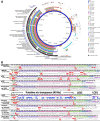Characterisation of the Paenarthrobacter nicotinovorans ATCC 49919 genome and identification of several strains harbouring a highly syntenic nic-genes cluster
- PMID: 37697273
- PMCID: PMC10494377
- DOI: 10.1186/s12864-023-09644-3
Characterisation of the Paenarthrobacter nicotinovorans ATCC 49919 genome and identification of several strains harbouring a highly syntenic nic-genes cluster
Abstract
Background: Paenarthrobacter nicotinovorans ATCC 49919 uses the pyridine-pathway to degrade nicotine and could provide a renewable source of precursors from nicotine-containing waste as well as a model for studying the molecular evolution of catabolic pathways and their spread by horizontal gene transfer via soil bacterial plasmids.
Results: In the present study, the strain was sequenced using the Illumina NovaSeq 6000 and Oxford Nanopore Technology (ONT) MinION platforms. Following hybrid assembly with Unicycler, the complete genome sequence of the strain was obtained and used as reference for whole-genome-based phylogeny analyses. A total of 64 related genomes were analysed; five Arthrobacter strains showed both digital DNA-DNA hybridization and average nucleotide identity values over the species threshold when compared to P. nicotinovorans ATCC 49919. Five plasmids and two contigs belonging to Arthrobacter and Paenarthrobacter strains were shown to be virtually identical with the pAO1 plasmid of Paenarthrobacter nicotinovorans ATCC 49919. Moreover, a highly syntenic nic-genes cluster was identified on five plasmids, one contig and three chromosomes. The nic-genes cluster contains two major locally collinear blocks that appear to form a putative catabolic transposon. Although the origins of the nic-genes cluster and the putative transposon still elude us, we hypothesise here that the ATCC 49919 strain most probably evolved from Paenarthrobacter sp. YJN-D or a very closely related strain by acquiring the pAO1 megaplasmid and the nicotine degradation pathway.
Conclusions: The data presented here offers another snapshot into the evolution of plasmids harboured by Arthrobacter and Paenarthrobacter species and their role in the spread of metabolic traits by horizontal gene transfer among related soil bacteria.
Keywords: Catabolic transposon; Evolution; Nicotine metabolism; Paenarthrobacter; Plasmids.
© 2023. BioMed Central Ltd., part of Springer Nature.
Conflict of interest statement
The authors declare no competing interests.
Figures




Similar articles
-
pAO1 of Arthrobacter nicotinovorans and the spread of catabolic traits by horizontal gene transfer in gram-positive soil bacteria.J Mol Evol. 2013 Aug;77(1-2):22-30. doi: 10.1007/s00239-013-9576-x. J Mol Evol. 2013. PMID: 23884627
-
Exploration of Nicotine Metabolism in Paenarthrobacter nicotinovorans pAO1 by Microbial Proteomics.Adv Exp Med Biol. 2019;1140:515-529. doi: 10.1007/978-3-030-15950-4_30. Adv Exp Med Biol. 2019. PMID: 31347068
-
A soil bacterial catabolic pathway on the move: Transfer of nicotine catabolic genes between Arthrobacter genus megaplasmids and invasion by mobile elements.J Biosci. 2020;45:58. J Biosci. 2020. PMID: 32345784
-
Microbiology and biochemistry of nicotine degradation.Appl Microbiol Biotechnol. 2006 Jan;69(5):493-8. doi: 10.1007/s00253-005-0226-0. Epub 2005 Dec 7. Appl Microbiol Biotechnol. 2006. PMID: 16333621 Review.
-
Bacterial catabolism of nicotine: Catabolic strains, pathways and modules.Environ Res. 2020 Apr;183:109258. doi: 10.1016/j.envres.2020.109258. Epub 2020 Feb 19. Environ Res. 2020. PMID: 32311908 Review.
Cited by
-
Insights into Pharmacological Activities of Nicotine and 6-Hydroxy-L-nicotine, a Bacterial Nicotine Derivative: A Systematic Review.Biomolecules. 2023 Dec 23;14(1):23. doi: 10.3390/biom14010023. Biomolecules. 2023. PMID: 38254623 Free PMC article.
References
-
- Eberwein H, Gries FA. Decker K [On the decomposition of nicotine by bacterial enzymes. II. Isolation and characterization of a nicotine-splitting soil bacterium] Hoppe-Seyler’s Zeitschrift für Physiol Chemie. 1961;323:236–248. - PubMed
-
- Decker K, Bleeg H. Induction and purification of stereospecific nicotine oxidizing enzymes from Arthrobacter oxidans. Biochim Biophys Acta - Enzymol Biol Oxid. 1965;105:313–324. - PubMed
-
- Kodama Y, Yamamoto H, Amano N, Amachi T. Reclassification of two strains of Arthrobacter oxydans and proposal of Arthrobacter nicotinovorans sp. nov. Int J Syst Bacteriol. 1992;42:234–9. - PubMed
-
- Busse H-J. Review of the taxonomy of the genus Arthrobacter, emendation of the genus Arthrobacter sensu lato, proposal to reclassify selected species of the genus Arthrobacter in the novel genera Glutamicibacter gen. nov, Paeniglutamicibacter gen. nov. Pseudogluta Int J Syst Evol Microbiol. 2016;66:9–37. - PubMed
-
- Brandsch R. Microbiology and biochemistry of nicotine degradation. Appl Microbiol Biotechnol. 2006;69:493–498. - PubMed
MeSH terms
Substances
Supplementary concepts
Grants and funding
- PN-III-P4-ID-PCE-2020-0656/Romanian Ministry of Education and Research
- PN-III-P4-ID-PCE-2020-0656/Romanian Ministry of Education and Research
- PN-III-P4-ID-PCE-2020-0656/Romanian Ministry of Education and Research
- PN-III-P4-ID-PCE-2020-0656/Romanian Ministry of Education and Research
- PN-III-P4-ID-PCE-2020-0656/Romanian Ministry of Education and Research
LinkOut - more resources
Full Text Sources
Molecular Biology Databases

